Temporal Evolution of Vapor Pressure Deficit Observed in Six Locations of Different Brazilian Ecosystems and Its Relationship with Micrometeorological Variables
Abstract
:1. Introduction
2. Materials and Methods
2.1. Study Area
- Alta Floresta (AF-MT), Brazil (9.90835 S, 56.06439 W): The instrument is installed on top of the building of the Federal Institute of Mato Grosso (IFMT), which is located on the outskirts of Alta Floresta, close to an important highway in a region experiencing constant real estate growth. The main source of aerosols is forest fires. The instrument is well installed and has a 360-degree unobstructed view (https://aeronet.gsfc.nasa.gov/, accessed on 16 February 2023). For this site, a total of 4380 data points were used.
- Manaus (MA-AM) EMBRAPA, Brazil (2.89053 S, 59.96978 W): The instrument is installed approximately 30 km north of Manaus at EMBRAPA. It is located on top of a 15 m water box (https://aeronet.gsfc.nasa.gov/, accessed on 16 February 2023). For this site, a total of 2580 data points were used.
- Petrolina SONDA (Pet-PE), Brazil (9.06910 S, 40.32011 W): The Petrolina station is located in the Brazilian Northeast semi-arid region, which experiences high solar radiation. This region also has long drought periods and occasional heavy rainfall, strongly affected by El Niño and La Niña systems. The site is away from urban areas, situated in the EMBRAPA Agricultural Research Center for semi-arid climate. There is also a network of seven radio-linked meteorological stations around the radiometric station, managed by the local site manager (https://aeronet.gsfc.nasa.gov/, accessed on 16 February 2023). For this site, a total of 1410 data points were used.
- Rio Branco (RB-AC), Brazil (9.95747 S, 67.86935 W): This site is located on top of a 22 m tower in Rio Branco, Brazil (https://aeronet.gsfc.nasa.gov/, accessed on 16 February 2023). For this site, a total of 2940 data points were used.
- Fazenda Miranda (FM-MT), Brazil (1517 S, 5606 W): Located in the Cuiabá municipality. The vegetation is grass-dominated with sparse trees and shrubs, known as “campo sujo” or “dirty field” Cerrado [35]. For this site, a total of 1770 data points were used.
- Baía das Pedras Park (BP-MT), Brazil: Situated within the Private Natural Heritage Reserve—RPPN SESC (1639 S, 5647 W)—in the Poconé municipality, bordering the municipality of Barão de Melgaço (about 160 km from the capital Cuiaba). This region is part of the Pantanal, considered one of the largest sedimentation plains on Earth [36,37]. For this site, a total of 1080 data points were used.
2.2. Micrometeorological Measurements
2.3. Singular Spectrum Analysis
3. Results and Discussion
3.1. Temporal Variation of
3.2. Changes in Environmental Factors Associated with the Increase in and Wildfire Occurrences
3.3. Effects of Wildfire Aerosols and Insolation Ratio on and Other Environmental Factors in the Amazon Basin
3.4. Implications of Changes on Carbon Flux and Photosynthesis: A Case Study
4. Conclusions
Author Contributions
Funding
Data Availability Statement
Acknowledgments
Conflicts of Interest
References
- Mishra, V. Cherkauer, K.A. Retrospective droughts in the crop growing season: Implications to corn and soybean yield in the Midwestern United States. Agric. For. Meteorol. 2010, 150, 1030–1045. [Google Scholar] [CrossRef]
- Zhang, Q.; Manzoni, S.; Katul, G.; Porporato, A.; Yang, D. The hysteretic evapotranspiration—Vapor pressure deficit relation. J. Geophys. Res. Biogeosci. 2014, 119, 125–140. [Google Scholar] [CrossRef]
- Trenberth, K.E.; Dai, A.; van der Scheier, G.; Jones, P.D.; Barichivich, J.; Briffa, K.R.; Sheffield, J. Global warming and changes in drought. Nat. Clim. Chang. 2013, 4, 17–22. [Google Scholar] [CrossRef]
- Yang, Y.; Saatchi, S.S.; Xu, L.; Yu, Y.; Choi, S.; Phillips, N.; Kennedy, R.; Keller, M.; Knyazikhin, Y.; Myneni, R.B. Post-drought decline of the Amazon carbon sink. Nat. Commun. 2018, 9, 3172. [Google Scholar] [CrossRef]
- Sherwood, S.; Fu, Q.A. Drier future? Science 2014, 343, 737–739. [Google Scholar] [CrossRef]
- Collins, M.; Knutti, R.; Arblaster, J.; Dufresne, J.L.; Fichefet, T.; Friedlingstein, P.; Gao, X.; Gutowski, W.J.; Johns, T.; Krinner, G.; et al. Chapter 12—Long-term climate change: Projections, commitments and irreversibility. In Climate Change 2013: The Physical Science Basis; IPCC, Ed.; IPCC Working Group I Contribution to AR5; Cambridge University Press: Cambridge, UK, 2013. [Google Scholar]
- Barkhordarian, A.; von Storch, H.; Zorita, E.; Loikith, P.C.; Mechoso, C.R. Observed warming over northern South America has an anthropogenic origin. Clim. Dyn. 2017, 51, 1901–1914. [Google Scholar] [CrossRef]
- Barkhordarian, A.; Saatchi, S.S.; Behrangi, A.; Loikith, P.C.; Mechoso, C.R.A. Recent Systematic Increase in Vapor Pressure Deficit over Tropical South America. Sci. Rep. 2019, 9, 15331. [Google Scholar] [CrossRef] [Green Version]
- Mishra, A.K.; Singh, V.P. A review of drought concepts. J. Hydrol. 2010, 391, 202–216. [Google Scholar] [CrossRef]
- Cox, P.M.; Harris, P.P.; Huntingford, C.; Betts, R.A.; Collins, M.; Jones, C.D.; Jupp, T.E.; Marengo, J.A.; Nobre, C.A. Increasing risk of Amazonian drought due to decreasing aerosol pollution. Nature 2009, 453, 212–215. [Google Scholar] [CrossRef] [Green Version]
- Marengo, J.A. Interdecadal variability and trends of rainfall across the Amazon basin. Theor. Appl. Climatol. 2004, 78, 79–96. [Google Scholar] [CrossRef]
- Marengo, J.A.; Nobre, C.A.; Tomasella, J.; Oyama, M.D.; de Oliveira, G.S.; Oliveira, R.d.; Camargo, H.; Alves, L.M.; Brown, I.F. The drought of Amazonia in 2005. J. Clim. 2008, 21, 495–516. [Google Scholar] [CrossRef] [Green Version]
- Marengo, J.A. Long-term trends and cycles in the hydrometeorology of the Amazon basin since the late 1920s. Hydrol. Processes 2009, 23, 3236–3244. [Google Scholar] [CrossRef]
- Marengo, J.; Alves, L.M.; Soares, W.R.; Rodriguez, D.A.; Camargo, H.; Riveros, M.P.; Pabló, A.D. Two contrasting severe seasonal extremes in tropical South America in 2012: Flood in Amazonia and drought in northeast Brazil. J. Clim. 2013, 26, 9137–9154. [Google Scholar] [CrossRef]
- Phillips, O.L.; Aragão, L.E.; Lewis, S.L.; Fisher, J.B.; Lloyd, J.; López-González, G.; Malhi, Y.; Monteagudo, A.; Peacock, J.; Quesada, C.A.; et al. Drought sensitivity of the Amazon rainforest. Science 2009, 323, 1344–1347. [Google Scholar] [CrossRef] [PubMed] [Green Version]
- Lewis, S.; Brando, P.M.; Phillips, O.L.; van der Heijden, G.M.; Nepstad, D. The 2010 amazon drought. Science 2011, 331, 554. [Google Scholar] [CrossRef]
- Khanna, L.; Medvigy, D.; Fueglistaler, S.; Walko, R. Regional dry-season climate changes due to three decades of Amazonian deforestation. Nat. Clim. Change 2017, 7, 200–204. [Google Scholar] [CrossRef]
- Marengo, J.A.; Tomasella, J.; Alves, L.M.; Soares, W.R.; Rodriguez, D.A. The drought of 2010 in the context of historical droughts in the Amazon region. Geophys. Res. Lett. 2011, 38, L12703. [Google Scholar] [CrossRef] [Green Version]
- Nobre, C.A.; Sampaio, G.; Borma, L.S.; Castilla-Rubio, J.C.; Silva, J.S.; Cardoso, M. Land-use and climate change risks in the Amazon and the need of a novel sustainable development paradigm. Proc. Natl. Acad. Sci. USA 2016, 113, 10759–10768. [Google Scholar] [CrossRef]
- Davidson, E.; de Araújo, A.C.; Artaxo, P.; Balch, J.K.; Brown, I.F.; Bustamante, M.M.C.; Coe, M.T.; DeFries, R.S.; Keller, M.; Longo, M.; et al. The Amazon basin in transition. Nature 2012, 481, 321–328. [Google Scholar] [CrossRef]
- Anderson, M.C.; Hain, C.; Wardlow, B.; Pimstein, A.; Mecikalski, J.R.; Kustas, W.P. Evaluation of drought indices based on thermal remote sensing of evapotranspiration over the continental united states. J. Clim. 2010, 24, 8. [Google Scholar] [CrossRef]
- Lobell, D.; Roberts, M.; Schlenker, W.; Braun, N.; Little, B.; Rejesus, R.; Hammer, G. Greater sensitivity to Drought Accompanies Maize Yield Increase in the U.S. Midwest. Science 2014, 344, 516–519. [Google Scholar] [CrossRef]
- Gentine, P.; Chhang, A.; Rigden, A.; Salvucci, G. Evaporation estimates using weather station data and boundary layer theory. Geophys. Res. Lett. 2016, 43, 11661–11670. [Google Scholar] [CrossRef]
- Green, J.K.; Konings, A.G.; Alemohammad, S.H.; Berry, J.A.; Entekhabi, D.; Kolassa, J.; Gentine, P. Regionally strong feedbacks between the atmosphere and terrestrial biosphere. Nat. Geosci. 2017, 10, 410–414. [Google Scholar] [CrossRef]
- Green, J.K.; Konings, A.G.; Alemohammad, S.H.; Berry, J.A.; Entekhabi, D.; Kolassa, J.; Kimm, H.; Guan, K.; Gentine, P.; Wud, J.; et al. Redefining droughts for the U.S. Corn Belt: The dominant role of atmospheric vapor pressure deficit over soil moisture in regulating stomatal behavior of Maize and Soybean. Agric. For. Meteorol. 2020, 287, 107930. [Google Scholar]
- Lin, C.; Gentine, P.; Huang, Y.; Guan, K.; Kimm, H.; Zhou, S. Diel ecosystem conductance response to vapor pressure deficit is suboptimal and independent of soil moisture. Agric. For. Meteorol. 2018, 250–251, 24–34. [Google Scholar] [CrossRef]
- Novick, K.A.; Ficklin, D.L.; Stoy, P.C.; Williams, C.A.; Bohrer, G.; Oishi, A.C.; Phillips, R.P. The increasing importance of atmospheric demand for ecosystem water and carbon fluxes. Nat. Clim. Chang. 2016, 6, 1023–1027. [Google Scholar] [CrossRef] [Green Version]
- Sulman, B.N.; Roman, D.T.; Yi, K.; Wang, L.; Phillips, R.P.; Novick, K.A. High atmospheric demand for water can limit forest carbon uptake and transpiration as severely as dry soil. Geophys. Res. Lett. 2016, 43, 9686–9695. [Google Scholar] [CrossRef]
- Lobell, D.B.; Hammer, G.L.; McLean, G.; Messina, C.; Roberts, M.J.; Schlenker, W. The critical role of extreme heat for maize production in the united states. Nat. Clim. Chang 2013, 3, 497. [Google Scholar] [CrossRef]
- Ainsworth, E.A.; Ort, D.R. How do we improve crop production in a warming world. Plant Physiol. 2010, 154, 2. [Google Scholar] [CrossRef] [Green Version]
- Rigden, A.J.; Salvucci, G.D. Stomatal response to humidity and CO2 implicatedin recent decline in us evaporation. Glob. Change Biol. 2016, 23, 1140–1151. [Google Scholar] [CrossRef]
- Zhang, L.M.; Yu, G.-R.; Sun, X.-M.; Wen, X.-F.; Ren, C.-Y.; Fu, Y.-L.; Li, Q.-K.; Li, Z.-Q.; Liu, Y.-F.; Guan, D.-X.; et al. Seasonal variations of ecosystem apparent quantum yield (α) and maximum photosynthesis rate (Pmax) of different forest ecosystems in China. Agric. For. Meteorol. 2006, 137, 176–187. [Google Scholar] [CrossRef]
- Zhang, P.; Chen, S.; Zhang, W.; Miao, H.; Chen, J.; Han, X.; Lin, G. Biophysical regulations of NEE light response in a steppe and a cropland in Inner Mongolia. J. Plant Ecol. 2012, 5, 238–248. [Google Scholar] [CrossRef] [Green Version]
- Bao, X.; Li, Z.; Xie, F. Environmental influences on light response parameters of net carbon exchange in two rotation croplands on the North China Plain. Sci. Rep. 2019, 9, 18702. [Google Scholar] [CrossRef] [Green Version]
- Rodrigues, T.R.; Vourlitis, G.L.; de Lobo, F.A.; Santanna, F.B.; de Arruda, P.H.Z.; de Nogueira, J.S. Modeling canopy conductance under contrasting seasonal conditions for a tropical savanna ecosystem of south central Mato Grosso, Brazil. Agric. For. Meteorol. 2016, 218, 218–229. [Google Scholar] [CrossRef]
- Fantin-Cruz, I.; Girard, P.; Zeilhofer, P.; Collischonn, W.; Nunes Da Cunha, C. Historical reconstruction of floodplain inundation in the Pantanal (Brazil) using neural networks. J. Hydrol. 2011, 399, 376–384. [Google Scholar] [CrossRef]
- Paz, J.R.; Santana, C.C.; Silva, W.P.; Abreu, M.C.; Pigozzo, C.M. Guia de visitantes de nectarios extraflorais de Ipomoea carnea subsp. Fistulosa (Convolvulaceae) em uma aáea de semiárido antropizado da Bahia, Brasil. Acta Biol. Parana 2016, 45, 1–4. [Google Scholar]
- Schmid, O.; Artaxo, P.; Arnott, W.P.; Chand, D.; Gatti, L.V.; Frank, G.P.; Hoffer, A.; Schnaiter, M.; Andreae, M.O. Spectral light absorption by ambient aerosols influenced by biomass burning in the Amazon Basin I: Comparison and field calibration of absorption measurement techniques. Atmos. Chem. Phys. V 2006, 6, 3443–3462. [Google Scholar] [CrossRef] [Green Version]
- Rizzo, L.V.; Correia, A.L.; Artaxo, P.; Procópio, A.S.; Andreae, M.O. Spectral dependence of aerosol light absorption over the Amazon Basin. Atmos. Chem. Phys. 2011, 11, 8899–8912. [Google Scholar] [CrossRef] [Green Version]
- Romera, K.S. Dependência Espectral de Absorção e Propriedades óTicas de Aerossóis no Pantanal Mato-Grossense. Master’s Thesis, Instituto de Física, Universidade Federal de Mato Grosso, Cuiabá, Brazil, 2019. [Google Scholar]
- Dalmagro, H.J.; Zanella de Arruda, P.H.; Vourlitis, G.L.; Lathuillière, M.J.; de S. Nogueira, J.; Couto, E.G.; Johnson, M.S. Radiative forcing of methane fluxes offsets net carbon dioxide uptake for a tropical flooded forest. Glob. Chang. Biol. 2019, 25, 1967–1981. [Google Scholar] [CrossRef]
- Ghil, M.; Allen, M.R.; Dettinger, M.D.; Ide, K.; Kondrashoc, D.; Mann, M.E.; Robertson, A.W.; Saunders, A.; Tian, Y.; Varadi, F.; et al. Advanced Spectral Methods for Climatic Time Series. Rev. Geophys. 2002, 40, 1–41. [Google Scholar] [CrossRef] [Green Version]
- Farquhar, G.D.; Sharkey, T.D. Stomatal Conductance and Photosynthesis. Annu. Rev. Plant Physiol. 1982, 33, 317–345. [Google Scholar] [CrossRef]
- Souza, R.P.; Machado, E.C.; Silva, J.A.B.; Lagôa, A.M.M.A.; Silveira, J.A.G. Photosynthetic gas exchange, chlorophyll fluorescence and some associated metabolic changes in cowpea (Vigna unguiculata) during water stress and recovery. Environ. Exp. Bot. 2004, 51, 45–56. [Google Scholar] [CrossRef]
- França, B.T.; Andrade, M.P.; Ribeiro, C.B.M.; Hippert, H.S. Dinâmica do Uso do Solo e Alterações na Vazão da Bacia do Rio São Francisco no Início do Séc. XXI; Techinal Note; Revista de Gestão da Água da América Latina; Associação Brasileira de Recursos Hídricos—ABRHidro: Porto Alegre, Brazil, 2021; Volume 18. [Google Scholar]
- Santos, K.S.; Ignotti, E.; Oliveira, B.F.A. Mudanças Climáticas e suas Relações com o Uso da Terra no Município de Alta Floresta—Amazônia Meridional Brasileira. Biodiversidade Bras. 2021, 11, 1–11. [Google Scholar] [CrossRef]
- Do Carmom, L. Agricultura Urbana na Cidade de Rio Branco, Acre: Caracterização, Especialização e Subsídios ao Planejamento Urbano. Master’s Thesis, Universidade Federal de Viçosa, Viçosa, Brazil, 2006. [Google Scholar]
- Delgado, R.C.; Rodrigues, R.A.; Faria, A.L.L.; Daher, M. Uso do Sensoriamento Remoto na Estimativa dos Efeitos de Ilhas de Calor. Rev. Bras. CiêNcias Ambient. 2012, 25, 69–80. [Google Scholar]
- Stocker, T.F.; Qin, D.; Plattner, G.K.; Alexander, L.V.; Allen, S.K.; Bindoff, N.L.; Bréon, F.M.; Church, J.A.; Cubasch, U.; Emori, S.; et al. Technical summary. In Climate Change 2013: The Physical Science Basis. Contribution of Working Group I to the Fifth Assessment Report of the Intergovernmental Panel on Climate Change; Cambridge University Press, Ed.; Cambridge University Press: Cambridge, UK, 2013; pp. 33–115. [Google Scholar] [CrossRef]
- Dave, P.; Bhushan, M.; Venkataraman, C. Absorbing aerosol influence on temperature maxima: An observation based study over India. Atmos. Environ. 2020, 223, 117237. [Google Scholar] [CrossRef]
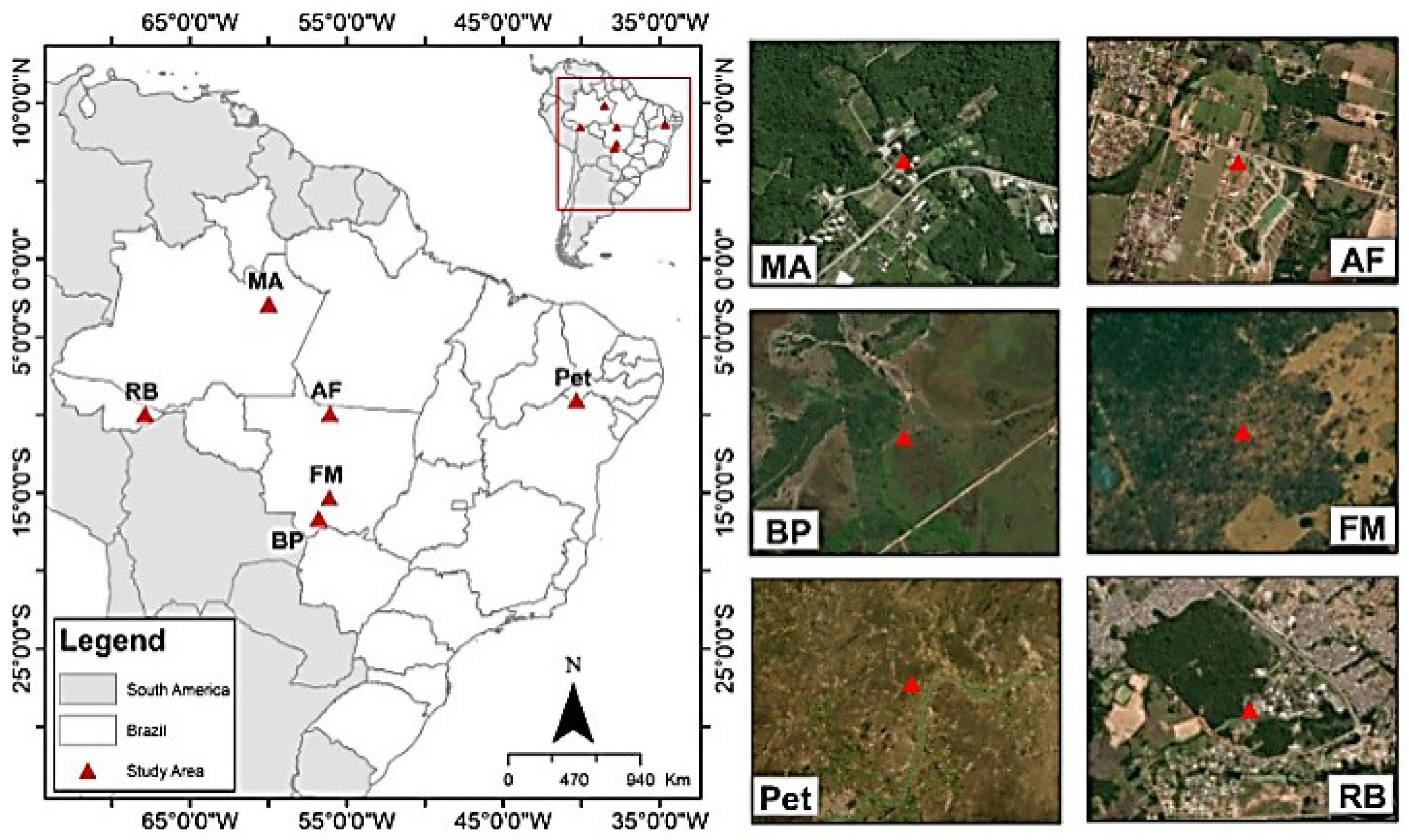

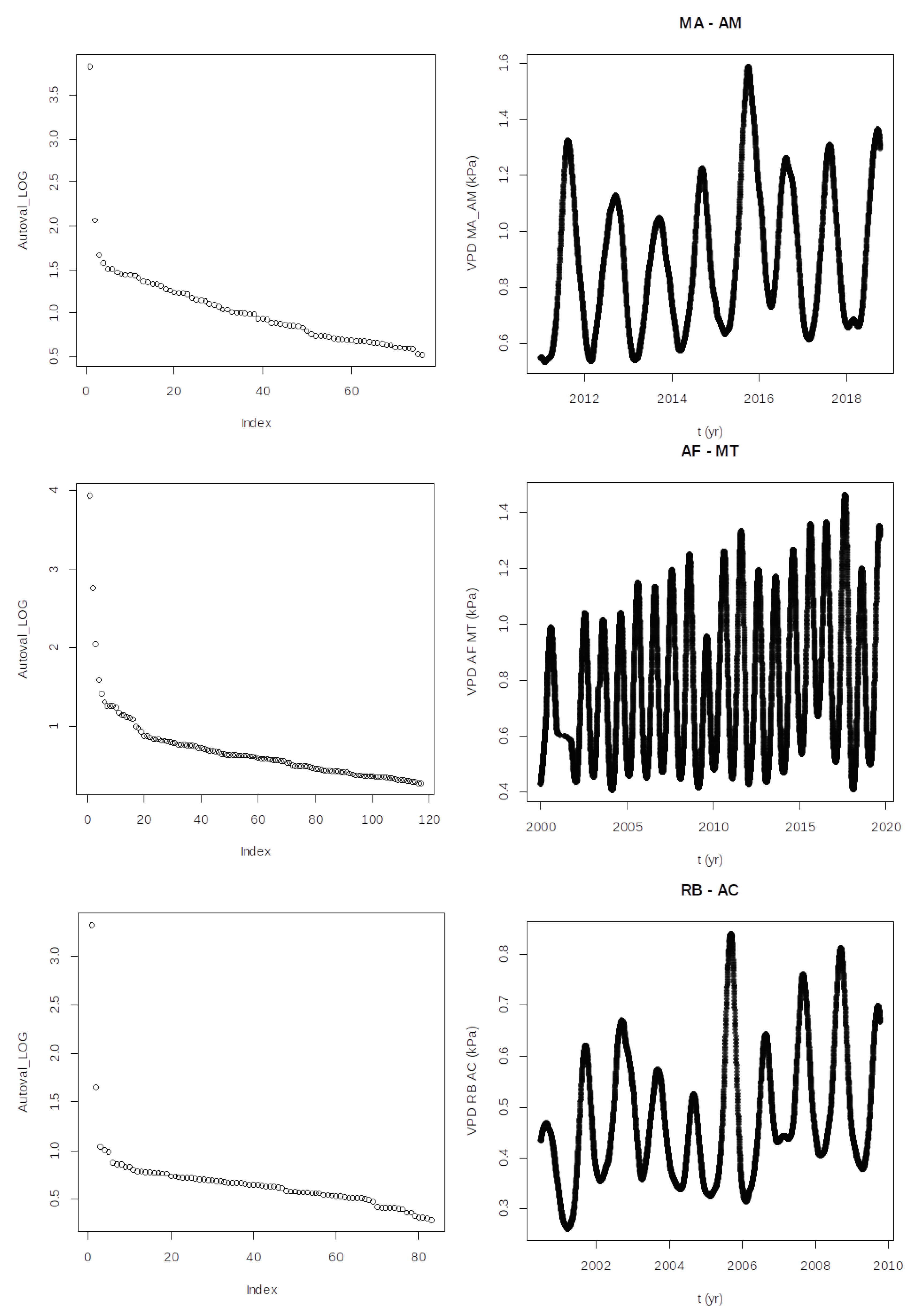
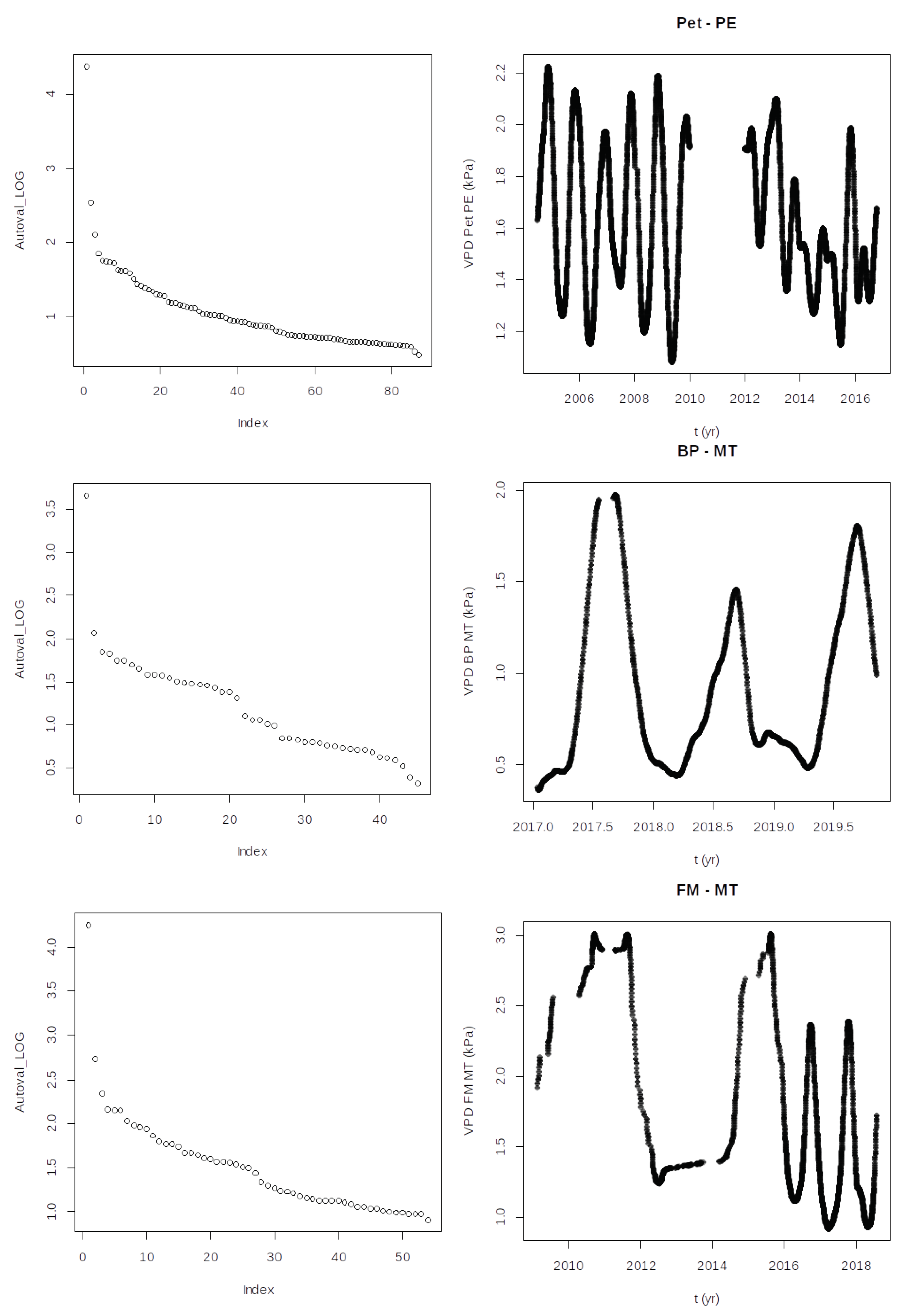
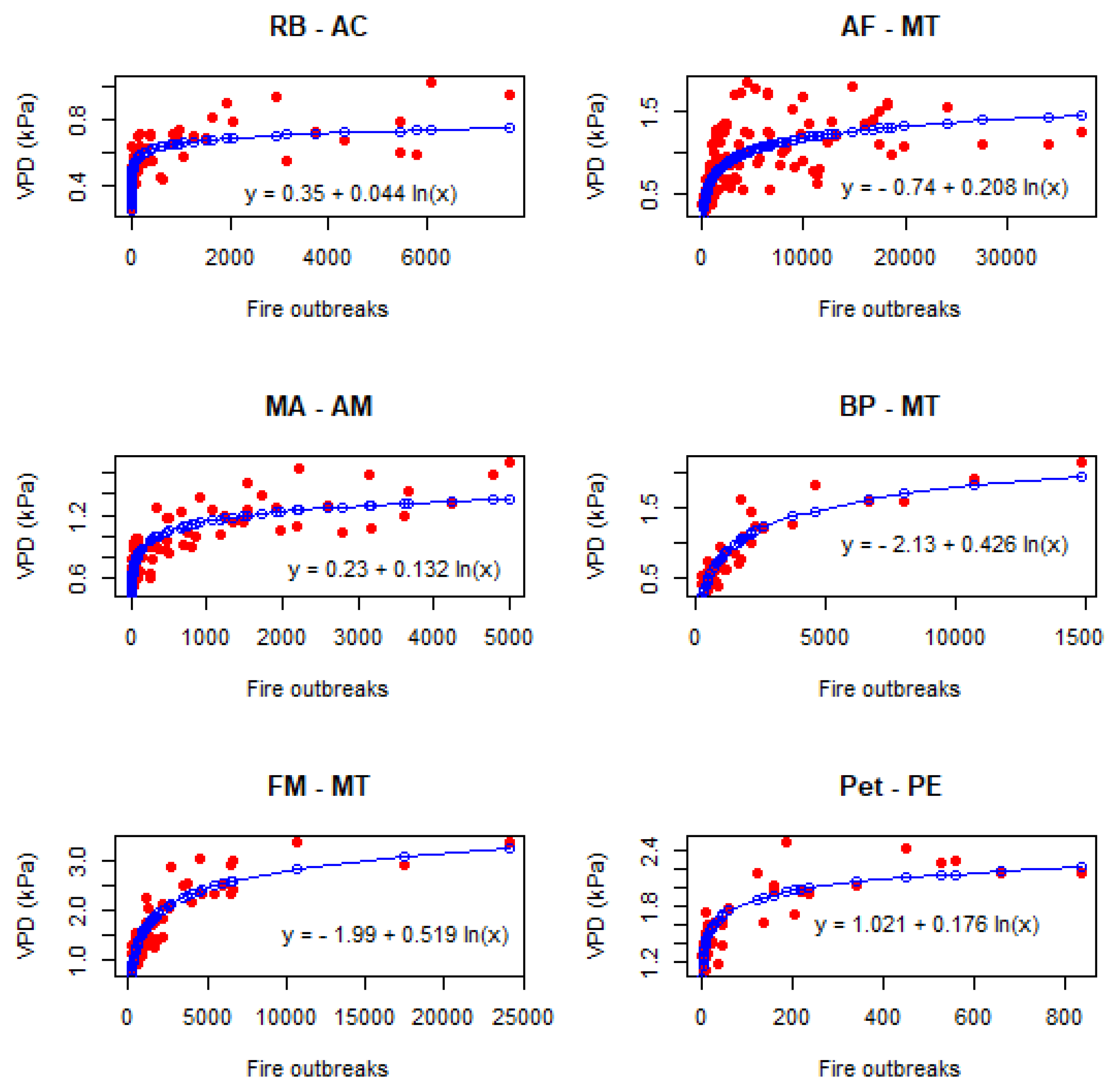

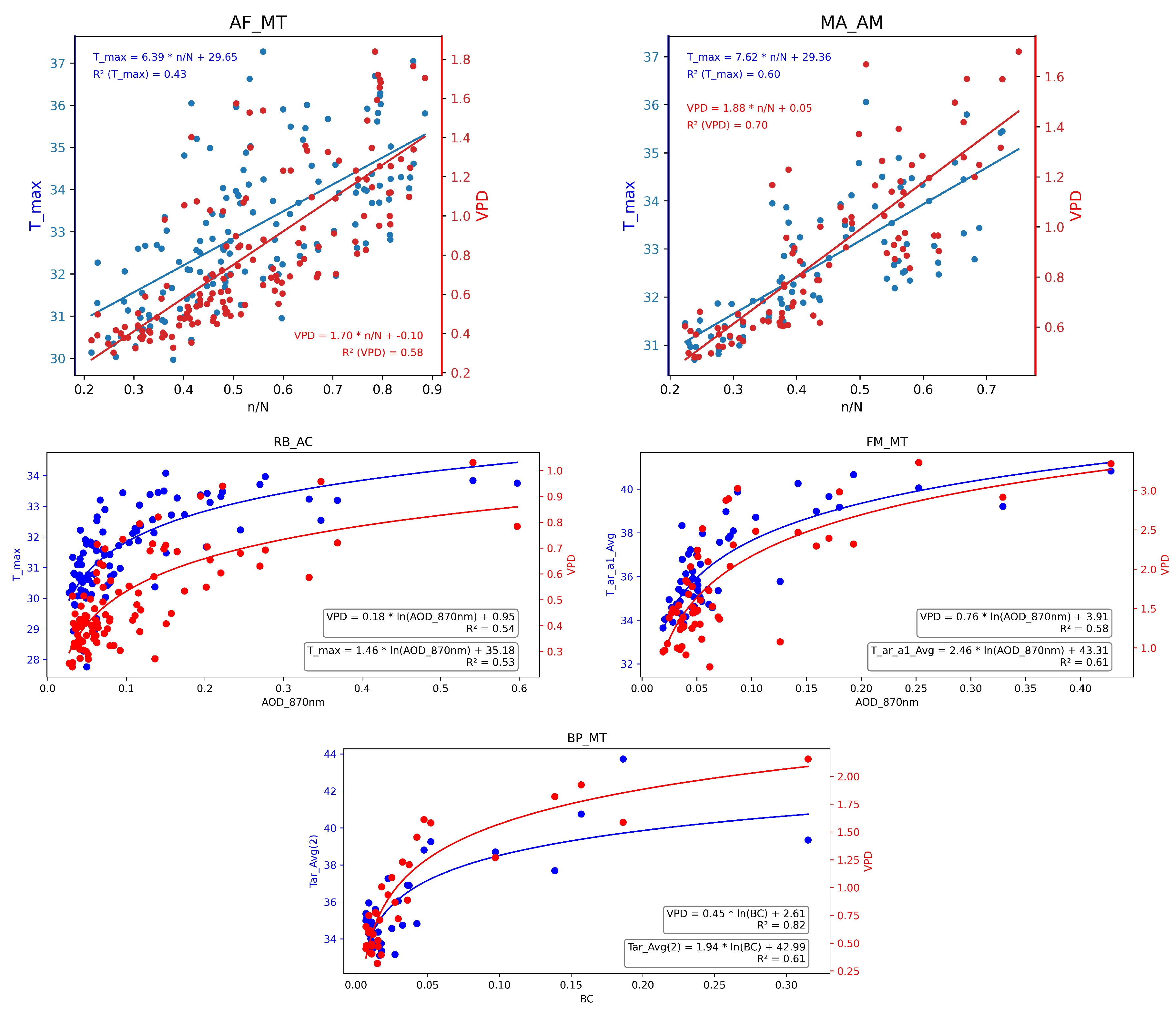
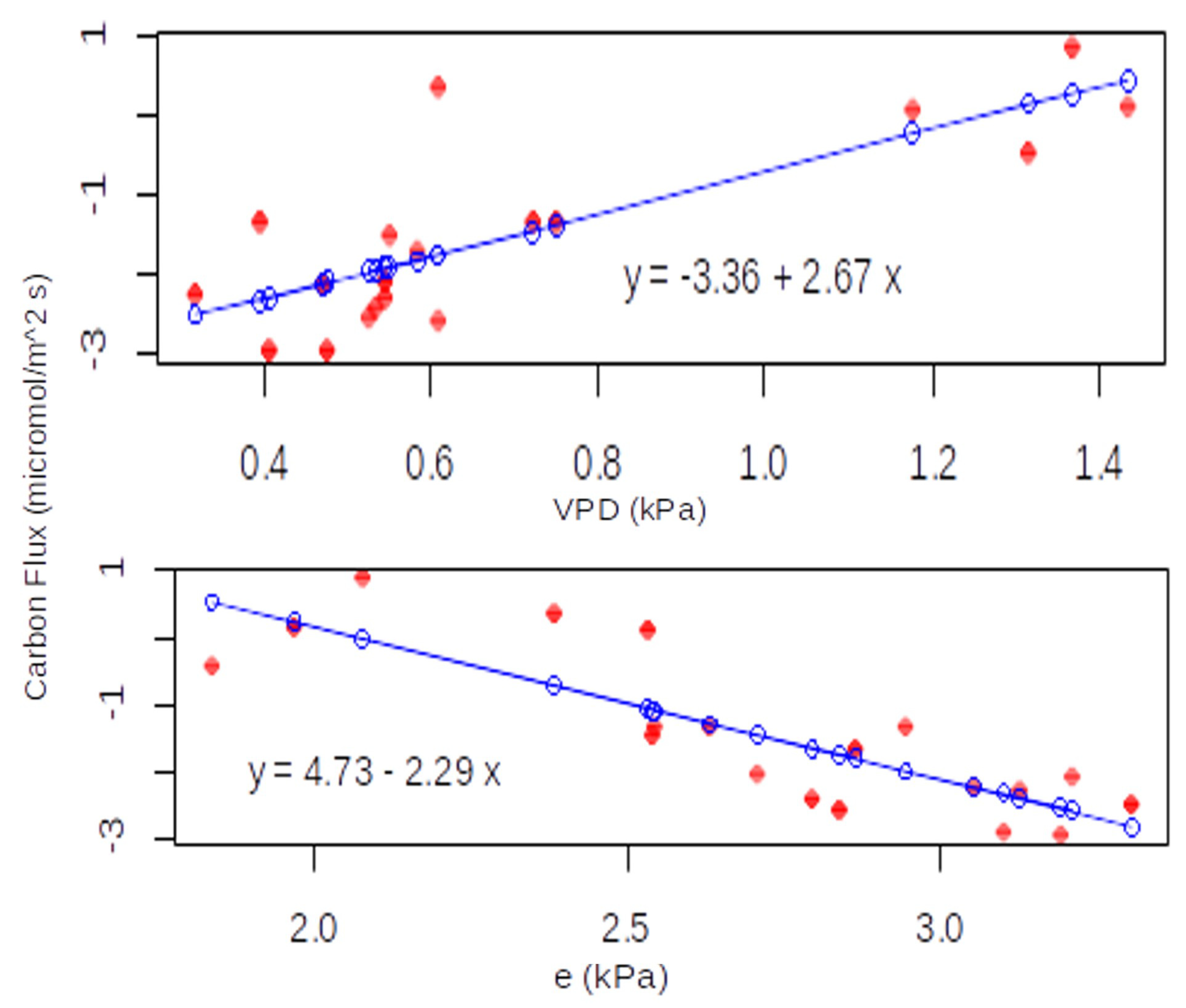
| Site | Min | Max | Avg | Std |
|---|---|---|---|---|
| AC-RB | 0.241 | 1.031 | 0.492 | 0.265 |
| AF | 0.302 | 1.839 | 0.828 | 0.471 |
| AM-MA | 0.478 | 1.700 | 0.897 | 0.465 |
| BP | 0.318 | 2.156 | 0.869 | 0.664 |
| FM | 0.759 | 3.359 | 1.743 | 0.964 |
| PE | 1.099 | 2.479 | 1.591 | 0.542 |
Disclaimer/Publisher’s Note: The statements, opinions and data contained in all publications are solely those of the individual author(s) and contributor(s) and not of MDPI and/or the editor(s). MDPI and/or the editor(s) disclaim responsibility for any injury to people or property resulting from any ideas, methods, instructions or products referred to in the content. |
© 2023 by the authors. Licensee MDPI, Basel, Switzerland. This article is an open access article distributed under the terms and conditions of the Creative Commons Attribution (CC BY) license (https://creativecommons.org/licenses/by/4.0/).
Share and Cite
Palácios, R.d.S.; de Paulo, S.R.; de Paulo, I.J.C.; Lobo, F.d.A.; Maionchi, D.d.O.; da Silva, H.J.A.; da Silva, I.M.C.B.; Marques, J.B.; Biudes, M.S.; Dalmagro, H.J.; et al. Temporal Evolution of Vapor Pressure Deficit Observed in Six Locations of Different Brazilian Ecosystems and Its Relationship with Micrometeorological Variables. Forests 2023, 14, 1543. https://doi.org/10.3390/f14081543
Palácios RdS, de Paulo SR, de Paulo IJC, Lobo FdA, Maionchi DdO, da Silva HJA, da Silva IMCB, Marques JB, Biudes MS, Dalmagro HJ, et al. Temporal Evolution of Vapor Pressure Deficit Observed in Six Locations of Different Brazilian Ecosystems and Its Relationship with Micrometeorological Variables. Forests. 2023; 14(8):1543. https://doi.org/10.3390/f14081543
Chicago/Turabian StylePalácios, Rafael da Silva, Sérgio Roberto de Paulo, Iramaia Jorge Cabral de Paulo, Francisco de Almeida Lobo, Daniela de Oliveira Maionchi, Haline Josefa Araujo da Silva, Ian Maxime Cordeiro Barros da Silva, João Basso Marques, Marcelo Sacardi Biudes, Higo José Dalmagro, and et al. 2023. "Temporal Evolution of Vapor Pressure Deficit Observed in Six Locations of Different Brazilian Ecosystems and Its Relationship with Micrometeorological Variables" Forests 14, no. 8: 1543. https://doi.org/10.3390/f14081543
APA StylePalácios, R. d. S., de Paulo, S. R., de Paulo, I. J. C., Lobo, F. d. A., Maionchi, D. d. O., da Silva, H. J. A., da Silva, I. M. C. B., Marques, J. B., Biudes, M. S., Dalmagro, H. J., Rodrigues, T. R., & Curado, L. F. A. (2023). Temporal Evolution of Vapor Pressure Deficit Observed in Six Locations of Different Brazilian Ecosystems and Its Relationship with Micrometeorological Variables. Forests, 14(8), 1543. https://doi.org/10.3390/f14081543











